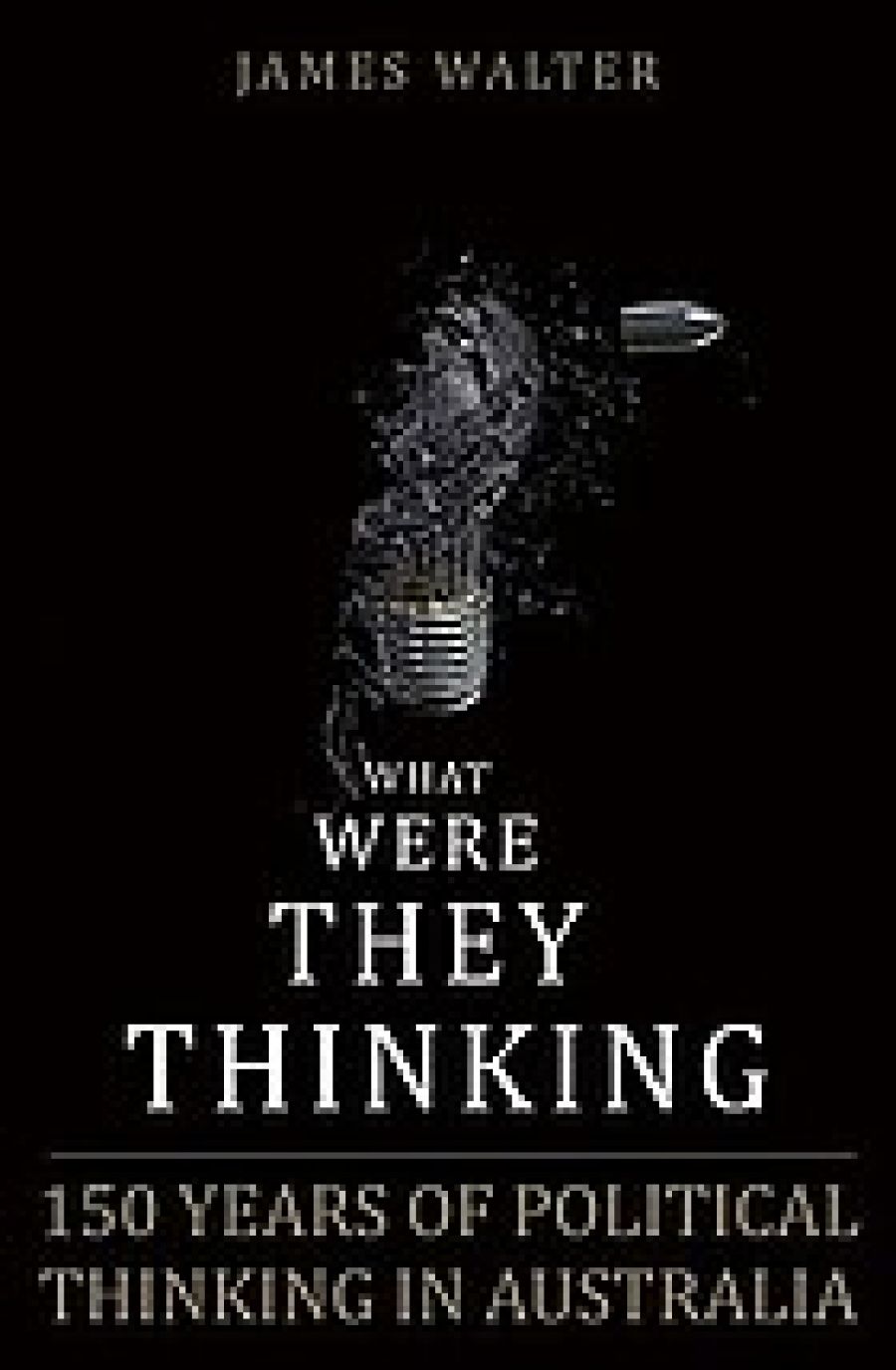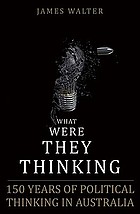
- Free Article: No
- Contents Category: Politics
- Review Article: Yes
- Article Title: History's hostage
- Online Only: No
- Custom Highlight Text:
A common criticism of Australian politics is that it is largely concerned with conflict over practical issues, rather than with debate over sophisticated political ideas. James Walter’s new book, What Were They Thinking?, challenges this view by providing a wide-ranging account of the development of Australian political ideas from the late nineteenth century to the present. The book is structured around changes in the role of the state in Australia, moving from the early disputes over democracy and responsible government in the late nineteenth century, to the Australian settlement, postwar reconstruction and the neo-liberal reforms of the 1980s and 1990s, through to the recent controversy over the Global Financial Crisis. While the changing role of the Australian state over time is well-covered territory, Walter’s contribution is to focus on the intellectual arguments that have facilitated and accompanied these changes, and to bring them together in a systematic account.
- Book 1 Title: What Were They Thinking?
- Book 1 Subtitle: The Politics of Ideas In Australia
- Book 1 Biblio: UNSW Press, $39.95 pb, 396 pp
- Book 1 Cover Small (400 x 600):

Walter examines the ideas of a wide array of politicians, public servants, public intellectuals and academics. He argues that there has been a tendency to underestimate the creativity of Australian political thinkers, who have often reinterpreted and adapted ‘mainstream Anglophone ideas’ to suit the Australian context. One example is Bruce Smith, who advanced a liberal case for conservatism in 1887, arguing that the fight to protect individual liberty had been won, and that liberals needed to embrace conservatism to guard against the illiberal tendencies of the working class. Another example is Meredith Atkinson, who criticised Australia’s system of wage arbitration for giving workers ‘a constant inducement to agitate for increases in wages’, engendering a lack of civic conscience. Other notable examples include Walter Murdoch’s attempts to link protectionism and civic competence, and H.C. Coombs’s application of Keynesian ideas to the Australian context.
Australian governments have also been innovative in their approach to policymaking. This is evident from the inception of national government, when Australia’s political leaders established the distinctive combination of policies that came to be known as the ‘Australian settlement’. It can also be seen in John Curtin and Ben Chifley’s approach to postwar reconstruction, Robert Menzies’ appeal to ‘the forgotten people’, Bob Hawke and Paul Keating’s attempt to blend neo-liberal policies with a commitment to redistribution and the social wage, and John Howard’s use of Australian values to defend conservative individualism.
A central theme of the book is the way in which intellectual history repeats itself. Consensus builds around a particular set of ideas until these ideas are challenged by an economic crisis that creates space for the spread of dissenting ideas. In time, these dissenting ideas take hold and become the new orthodoxy. Although Walter believes that this is a long-running pattern in Australian politics, he thinks that the dominance of neo-liberalism prior to the Global Financial Crisis was different from that of past intellectual orthodoxies. In former eras, ‘there had always been grounds for dissent, traditions of contest on which reformers would recurrently draw, and models of difference’, but by the late twentieth century, ‘all of these resources, it seemed, had failed. Intellectually, there was nowhere to go.’ Neo-liberalism became a ‘veto on politics’, because it was ‘the only frame within which government action, politics itself, could be conceived’, silencing dialogue and dissent.
The Global Financial Crisis appears to have undermined the dominance of neo-liberalism, although it is unclear whether this is a permanent change, and if so, which set of ideas will become the new orthodoxy. Walter discusses in detail the dispute between Prime Minister Kevin Rudd and then-Opposition Leader Malcolm Turnbull over neo-liberalism and the Global Financial Crisis in the first half of 2009. He highlights parallels between Rudd’s analysis of the crisis and Alfred Deakin’s comments on the state and social justice; and parallels between Turnbull’s position on the crisis and George Reid’s support for individual liberty and private enterprise. The fact that contemporary political leaders echo the ideas of politicians writing one hundred years ago demonstrates that ‘[c]ontemporary debate is always hostage to history, even when unconscious of it’.
What Were They Thinking? is an impressive achievement. Walter has managed to condense a wealth of research on a vast array of Australian political thinkers into a clear and readable survey of Australian political thought. The general reader is likely to find the book a stimulating and accessible intro-duction to the field, while specialists will also benefit from Walter’s analysis, although, as the author predicts, they will also find plenty to argue about.
For example, Walter claims that ‘[i]n reviewing our history, it is hard to avoid the conclusion that though our interest in and engagement with politics might be driven by ideals – democracy, equal opportunity, liberty, choice, self-determination, justice – the fundamental determinant of political reasoning is economic. Ideas that do not carry with them an answer to the problem of resource allocation – who gets what, when, how – are marginalised.’ Notwithstanding the centrality of economics to political debate, this is a controversial claim. Debates over nationalism, security, democracy and human rights are crucial to contemporary politics, and while these concepts can all have an economic dimension, their enduring importance is not merely reducible to economics. Walter could have devoted more attention to analysing debates over non-economic issues such as Australia’s involvement in the Iraq War and the government’s treatment of refugees. These were two of the most contentious policies of the Howard era, but neither was principally about economics. Activists, public intellectuals and academics devoted a lot of effort to making an intellectual case against these policies, but there is not much discussion of this in the book. Considering the importance of these issues, it would have been interesting to read a more in-depth analysis of the key ideas, and to see them placed in their broader historical context.
It also would have been good to see a more thorough investigation of debates over the institutional framework of Australian government. Although Walter discusses in detail colonial disputes over democracy and responsible government, he pays relatively little attention to Australia’s democratic institutions in the remainder of the book. This is surprising, because Australia’s unique system of government has been the subject of lively academic and popular debate, particularly since the Dismissal. Much of this debate has centred on the desirability of the various counter-majoritarian checks built into the Australian system, which has led to arguments over the nature of democracy, the role of the Senate and the future of federalism; these have exercised journalists and politicians almost as much as political scientists and constitutional lawyers. These contemporary debates have interesting connections to the colonial arguments over democracy, responsible government and liberty that are discussed earlier in the book, so it would have been interesting for Walter to tease out the connections.
Nonetheless, omissions are inevitable in a work of this scope. Walter ranges over a vast intellectual territory, and the size and complexity of the terrain prevents him from discussing every interesting or important idea. Rather than exploring ‘every tributary and byway’, he aims to provide an overview, a ‘rough guide to the principal currents of debate in Australian politics’. What Were They Thinking? achieves this aim successfully and, in all, is a welcome addition to the growing literature on Australian political thought.


Comments powered by CComment